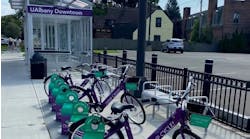Advancements in mobile data delivery has opened a substantial opportunity for transit agencies to improve the overall transit experience, attract riders, and create a new revenue stream to help supplement operations, improve service to core constituents, and support area business.
It’s no secret that revenue and funding represent two persistent issues for transit agencies across the country. Ridership is down in most major cities[1] and fares are on the rise. Mass transit operators are caught in a difficult position as they know the demographics of their riders skew toward lower income households with 65.7 percent earning under 50,000 per year.[2] Rising costs seem at odds with an industry whose primary users are those of limited financial means.
Modern intelligent transit systems (ITS) go a long way in optimizing the operations and efficiency of mass transportation operations. They can streamline routes. Data collected from these systems can help identify obsolete stops, save on fuel expenses, and identify passenger behavior. While these systems can help skinny up the bottom line, they don’t provide a new pathway to increased revenue.
For that, you need advertising.
Placing ads on mass transit vehicles isn’t a new concept. We’re all familiar with big printed signs plastered on the sides of the local bus, or larger-than-life posters displayed at stops. But print is very 20th century, and our society is very high-tech — and very connected.
That’s where on-board and at-station infotainment systems come into play.
If you’re not familiar with the concept, infotainment provides a multimedia platform that delivers both crucial and entertaining information to travelers via existing or new-installs of high-definition digital displays. The implementation of an infotainment system helps agencies leverage captive “eyeballs” in ways that improve the rider experience and can generate a potentially huge revenue stream through the sales of advertising or other content.
An infotainment display can provide riders with system alerts and update, and other useful information such as weather forecasts, recorded local news broadcasts, or GPS- or time-triggered advertising.
For example, the Metro in Washington, D.C. is expected to earn over $20 million in advertising revenue this year. It’s high definition display outperform static, printed ads by 400 percent (Klein, 2017).
In the Minneapolis/St. Paul, Minnesota, their Metro Transit operations will see 65 percent of its revenue come from just 38 displays at two stations (Klein, 2017).
The presence of digital displays provides greater inventory than traditional static, printed placards. This means that more ads can be sold on vehicles and transit stations, which translates into a greater opportunity for higher advertising revenue. Pair this with the GPS-enabled features of an ITS and transit agencies can pair placement with timing by triggering ads to run as specific locations or times, such as when the bus passes right next to a participating store or restaurant.
The size of a transit agency is of little concern. Even small, five to 10 bus service can benefit from incorporating these systems on their vehicles. A common concern is going to be bandwidth; large transit agencies have larger budgets and can devote resources to selling space on their vehicles. Smaller agencies however, have minimal staffing and certainly very little time to devote to advertising sales.
“Partnerships are extremely important, especially for the smaller agencies,” added Maglio. “Many billboard companies such as Comcast or Lamar may be ideal candidates to sell into your available inventory, as will local advertising agencies. Making these places aware of the existence of these systems makes generating revenue far easier.”
Infotainment systems can inject critical new funding into any transit operation while increasing brand value and improving the overall ridership experience. “It certainly makes for a more enjoyable ride and affords the transit agencies the resources to make significant investments into other areas of their operations,” concluded Maglio.
Boca Raton, Florida-based ETA Transit Systems provides complete intelligent transit systems, including infotainment solutions.


